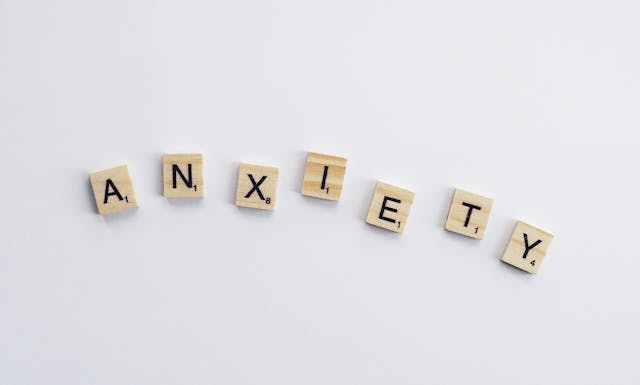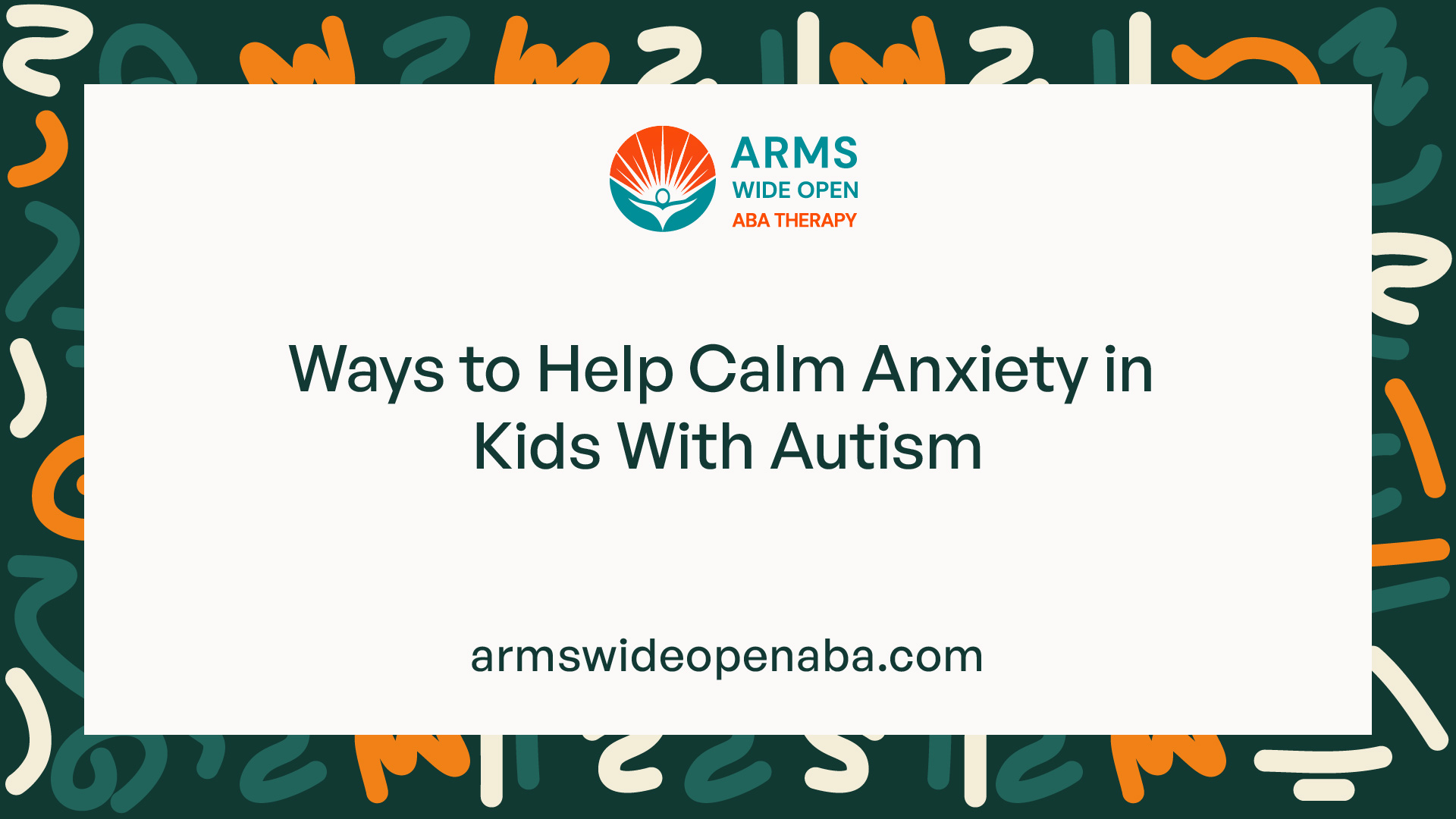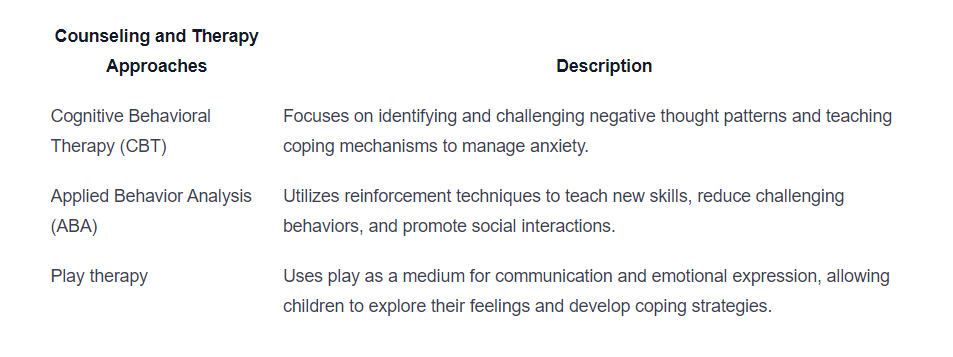Ways to Help Calm Anxiety in Kids With Autism
Discover effective tools to calm anxiety in kids with autism. From sensory strategies to communication techniques, help them thrive!

Understanding Anxiety in Kids with Autism
Anxiety is a common challenge faced by many children with autism. Understanding how anxiety manifests in children with autism and the importance of addressing it is crucial for providing the necessary support and intervention.

How Anxiety Manifests in Children with Autism
Anxiety in children with autism can present itself in various ways, often influenced by individual differences and sensory sensitivities. Some common manifestations of anxiety in these children include:
- Social Anxiety: Children with autism may experience anxiety in social situations, often struggling with initiating or maintaining conversations, understanding social cues, or forming friendships.
- Rigid Thinking and Rituals: Anxiety can lead to rigid thinking patterns and the need for specific rituals or routines. Any deviation from these routines may cause distress and heightened anxiety levels.
- Sensory Overload: Sensory sensitivities are prevalent in children with autism, and when overwhelmed by sensory stimuli, they may experience increased anxiety. This can include sensitivity to noise, light, touch, or certain textures.
- Transitions and Change: Children with autism often find it challenging to cope with transitions or unexpected changes in their environment or routine. These situations can trigger anxiety and result in behavioral issues.
Importance of Addressing Anxiety in Children with Autism
Addressing anxiety in children with autism is of utmost importance as it can significantly impact their overall well-being, daily functioning, and quality of life. By recognizing and addressing anxiety, we can:
- Enhance Emotional Regulation: Managing anxiety helps children with autism develop effective coping strategies and emotional regulation skills. This, in turn, can lead to improved self-esteem and a greater sense of control.
- Improve Social Interaction: Reducing anxiety allows children to engage more comfortably in social interactions, fostering connections and friendships with peers.
- Promote Learning and Academic Success: Anxiety can interfere with a child's ability to focus, concentrate, and engage in learning activities. By addressing anxiety, we create a conducive environment for academic growth and success.
- Reduce Challenging Behaviors: Anxiety can contribute to challenging behaviors such as meltdowns or aggression in children with autism. By managing anxiety, we can often mitigate these behaviors and create a more harmonious environment.
Recognizing the manifestations of anxiety in children with autism and understanding the importance of addressing it paves the way for effective strategies and interventions. By providing the necessary support and tools, we can help children with autism navigate their anxiety and thrive in their daily lives.
Creating a Calming Environment
When it comes to helping children with autism manage their anxiety, creating a calming environment is essential. By making a few adjustments to the surroundings, you can provide a sense of comfort and security. In this section, we will explore two effective strategies: sensory-friendly spaces and establishing predictability and routine.
Sensory-Friendly Spaces
Sensory-friendly spaces are designed to accommodate the unique sensory needs of children with autism. These spaces provide a calming and safe environment where children can relax and regulate their sensory experiences. Here are some key elements to consider when creating sensory-friendly spaces:
- Lighting: Use soft, dimmable lighting to reduce harsh glare and create a soothing atmosphere. Natural light is preferable whenever possible.
- Noise Level: Minimize background noise and provide sound-absorbing materials, such as carpets or curtains, to reduce auditory distractions. Consider using white noise machines or calming music to create a more soothing ambiance.
- Colors: Opt for neutral or muted colors on the walls and furniture to create a calming effect. Avoid bright or overwhelming color schemes that may overstimulate the child.
- Comfortable Seating: Provide comfortable seating options, such as bean bags or soft cushions, that offer a cozy and secure feeling. Incorporating weighted blankets or lap pads can also provide deep pressure input, which is known to have a calming effect.
Establishing Predictability and Routine
Children with autism often thrive in environments with predictability and routine. Establishing a consistent schedule can help reduce anxiety and provide a sense of security. Here are some ways to create predictability and routine:
- Visual Schedules: Use visual schedules or calendars to help children understand and anticipate their daily activities. Include pictures or symbols to represent each task or event, making it easier for the child to follow along and know what to expect.
- Transition Strategies: Transitioning from one activity to another can be challenging for children with autism. Use visual timers or countdowns to signal upcoming transitions and allow for sufficient time to prepare.
- Clear Communication: Provide clear and concise instructions to help children understand expectations. Use visual supports, such as visual cues or social stories, to reinforce important information and clarify any potential uncertainties.
- Consistent Bedtime Routine: Establish a consistent bedtime routine that incorporates calming activities like reading, relaxation exercises, or listening to soothing music. This routine can help signal the brain and body that it's time to unwind and prepare for sleep.
Creating a calming environment that addresses the sensory needs of children with autism and establishing predictability through routines can significantly help reduce anxiety and promote a sense of well-being. By implementing these strategies, you can provide a supportive environment that fosters relaxation and emotional stability for children with autism.
Tools and Techniques for Calming Anxiety
When it comes to helping children with autism manage their anxiety, there are various tools and techniques available that can make a significant difference in their overall well-being. In this section, we will explore three effective methods: deep pressure therapy, visual supports and social stories, and breathing exercises and mindfulness activities.
Deep Pressure Therapy
Deep pressure therapy, also known as deep touch pressure, involves applying gentle, firm pressure to the body. This technique has been found to have a calming effect on children with autism by providing a sense of security and reducing anxiety.
There are different ways to implement deep pressure therapy, including:
- Weighted blankets: These blankets have evenly distributed weights that provide a comforting, cocoon-like sensation, promoting relaxation and reducing anxiety.
- Compression garments: Compression vests or shirts can help provide a gentle, constant pressure to the body, which can have a calming effect on children with autism.
Visual Supports and Social Stories
Visual supports and social stories are powerful tools for helping children with autism understand and navigate their emotions, including anxiety. These tools use visual aids, such as pictures, symbols, or written words, to provide structure, predictability, and support.
- Visual schedules: Visual schedules help children with autism understand what activities or tasks are coming up, reducing anxiety by providing a clear and predictable routine.
- Social stories: Social stories are personalized narratives that describe social situations or events in a step-by-step manner. They help children with autism understand and prepare for different situations, alleviating anxiety by providing guidance and reassurance.
Breathing Exercises and Mindfulness Activities
Breathing exercises and mindfulness activities can be effective in promoting relaxation and reducing anxiety in children with autism. These techniques help children focus on their breathing and the present moment, fostering a sense of calmness.
- Deep breathing: Deep breathing exercises involve taking slow, deep breaths, holding for a few seconds, and then exhaling slowly. This practice helps regulate the body's stress response system and promotes a sense of calm.
- Mindfulness activities: Mindfulness activities, such as guided meditation or body scans, encourage children to pay attention to their thoughts, emotions, and bodily sensations in a non-judgmental way. These activities can help children with autism develop self-awareness and cope with anxiety.
By incorporating these tools and techniques into the daily routine of children with autism, parents, caregivers, and educators can provide valuable support in managing anxiety. It's important to remember that each child is unique, so it may be helpful to experiment with different strategies to find what works best for them.
Incorporating Sensory Strategies
Children with autism often benefit from incorporating sensory strategies to help calm their anxiety. These strategies focus on providing sensory input that can help regulate their nervous system and create a sense of calm. In this section, we will explore some effective sensory strategies: sensory diet activities, sensory tools and toys, and sensory-friendly clothing and accessories.
Sensory Diet Activities
A sensory diet involves incorporating specific activities throughout the day to provide the sensory input that a child with autism needs. These activities are tailored to the individual's sensory preferences and can help them regulate their emotions and reduce anxiety. Some examples of sensory diet activities include:
- Swinging: Swinging back and forth on a swing can provide deep pressure input and promote a sense of calm.
- Jumping on a trampoline: This activity provides proprioceptive input and can help children with autism regulate their sensory systems.
- Playing with textured materials: Engaging in activities that involve tactile stimulation, such as playing with sand or clay, can be soothing for children with autism.
It's important to note that sensory diet activities should be individualized based on the child's sensory needs and preferences. Working with an occupational therapist can help develop a personalized sensory diet plan.
Sensory Tools and Toys
Sensory tools and toys can be valuable resources in calming anxiety for children with autism. These items are designed to provide specific types of sensory input and can be used in various settings. Here are some examples of sensory tools and toys:
Sensory Tools and Toys
Fidget spinners
Chewable necklaces
Weighted blankets
Noise-canceling headphones
Squeeze balls
These tools and toys can help redirect anxious energy, provide tactile stimulation, or create a calming effect through deep pressure. It's important to choose sensory tools and toys that are safe and appropriate for the child's age and developmental level.
Sensory-Friendly Clothing and Accessories
For some children with autism, certain clothing textures or tags can cause discomfort and increase anxiety. Sensory-friendly clothing and accessories are designed to minimize sensory challenges and promote comfort. Features of sensory-friendly clothing may include:
- Seamless construction: Clothing without seams can prevent irritation and discomfort.
- Soft and breathable fabrics: Fabrics like cotton or bamboo can provide a sensory-friendly experience.
- Tagless labels: Labels that are printed directly on the garment can eliminate the annoyance of traditional tags.
By providing clothing and accessories that cater to the sensory needs of children with autism, it can help reduce anxiety and increase their overall comfort throughout the day.
Incorporating sensory strategies such as sensory diet activities, sensory tools and toys, and sensory-friendly clothing and accessories can play a significant role in calming anxiety for children with autism. These strategies can be personalized to suit the individual needs of each child and should be implemented in collaboration with parents, educators, and occupational therapists to ensure the best possible outcomes.
Communication and Social Support
Helping children with autism navigate anxiety requires effective communication and social support. By employing various strategies, parents, caregivers, and educators can provide the necessary tools to help calm anxiety in these children.
Using Social Scripts
Social scripts are a helpful tool for children with autism to understand and navigate social situations. These scripts provide a structured framework for communication and social interactions. By using visual supports, such as pictures or written prompts, social scripts help children anticipate and understand what to expect in different scenarios.

Social scripts can be personalized to address specific anxiety triggers or challenging situations. By providing clear and concise instructions, social scripts empower children with autism to navigate social interactions confidently.
Peer Support Programs
Peer support programs offer children with autism the opportunity to interact and connect with peers who may share similar experiences. These programs create a supportive environment where children can build social skills, develop friendships, and learn from one another.

Peer support programs foster a sense of belonging and promote social development, which can help reduce anxiety and increase self-confidence in children with autism.
Professional Counseling and Therapy
Professional counseling and therapy play a crucial role in helping children with autism manage anxiety. Licensed therapists, experienced in working with individuals on the autism spectrum, can provide specialized interventions and strategies tailored to the unique needs of each child.

Through counseling and therapy, children with autism can learn strategies to cope with anxiety, build emotional resilience, and enhance their overall well-being.
By incorporating effective communication strategies like social scripts, providing opportunities for peer support, and seeking professional counseling and therapy, children with autism can receive the necessary social support to navigate anxiety and thrive in their daily lives.
Collaborating with Educators and Professionals
When it comes to helping children with autism manage anxiety, collaboration with educators and professionals plays a crucial role. These individuals have the expertise and resources to provide targeted support and create a supportive environment for the child. In this section, we will explore three important aspects of collaboration: Individualized Education Programs (IEPs), Behavior Intervention Plans (BIPs), and working with occupational therapists and speech therapists.
Individualized Education Programs (IEPs)
An Individualized Education Program (IEP) is a personalized plan designed to address the unique needs of a child with autism. It is developed collaboratively by a team that typically includes educators, parents, and other professionals involved in the child's education. An IEP outlines specific goals, accommodations, and support services to help the child succeed academically and socially.
The IEP team assesses the child's strengths and challenges and develops strategies to address anxiety within the educational setting. This may include implementing visual supports, providing sensory breaks, or incorporating calming techniques into the child's daily routine. The IEP team works together to ensure that the child's anxiety is acknowledged and appropriate supports are in place.
Behavior Intervention Plans (BIPs)
A Behavior Intervention Plan (BIP) is a proactive approach to addressing challenging behaviors, including anxiety, in children with autism. It is developed based on a functional behavior assessment, which helps identify the triggers and functions of the behavior. A BIP outlines strategies and interventions to reduce anxiety-related behaviors and promote positive coping mechanisms.
The development of a BIP involves collaboration between educators, parents, and other professionals who work closely with the child. The plan includes specific goals, strategies, and supports tailored to the child's unique needs. By addressing anxiety-related behaviors within the BIP, educators can create a structured and supportive learning environment that fosters emotional well-being.
Working with Occupational Therapists and Speech Therapists
Occupational therapists (OTs) and speech therapists (STs) are valuable members of the collaborative team when it comes to helping children with autism manage anxiety. OTs can provide sensory integration techniques, such as deep pressure therapy or sensory diet activities, to help regulate the child's sensory experiences and reduce anxiety. STs can assist in developing social communication skills and using social scripts to navigate social situations, which can help alleviate anxiety in social settings.
Collaboration with OTs and STs involves regular communication and sharing of information between educators, therapists, and parents. By working together, the team can integrate therapy techniques and strategies into the child's daily routine, both at school and at home. This collaborative approach ensures consistency and reinforces the child's coping skills across different environments.
Collaborating with educators and professionals is essential in supporting children with autism in managing anxiety. Through the development of individualized plans, such as IEPs and BIPs, and the expertise of occupational therapists and speech therapists, a comprehensive and tailored approach can be implemented to create a nurturing and supportive environment for the child.
Sources
https://harkla.co/blogs/special-needs/calm-anxiety-in-kids-with-autism
https://www.verywellhealth.com/how-to-calm-a-child-with-autism-4177696
https://www.crossrivertherapy.com/autism/calming-strategies
Similar articles
We’re here to help you

Our team is here to assist you in this process. Contact us for any assistance.
it’s easy to apply
We Accept Most Insurances
Our in-network insurance partnerships make ABA therapy more accessible to families throughout our service areas.







Our Insurance Process
We'll request your insurance details to help us verify your plan's coverage for ABA therapy. Once we've received this information, we'll walk you through your benefits, including copayments, deductibles and out-of-pocket maximums, so you know what to expect in advance.
Our team will then handle the preauthorization and all the necessary paperwork.
.svg)





















.jpeg)


































.jpeg)




.jpeg)







.jpeg)











.jpeg)
















